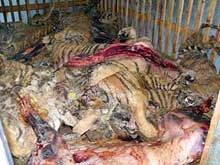|
Update


June 12, 2008
The World Bank’s portfolio is development—a global war on poverty. It “has rarely taken on wildlife conservation efforts of endangered species,” Reuters wrote today. But it is making an exception for the critically endangered tiger.
World Bank President Robert Zoellick said the decline in the number of [wild] tigers was "shocking" from over 100,000 a century ago to currently 5,574. . . . [As you know if you’ve followed our tiger debate, there are an estimated 15,000 captive tigers in private hands just in the U.S. Some percentage may have genetic value, but the challenges of reintroducing captive-born tigers into the wild are overwhelming.]

The new Tiger Conservation Initiative will bring together wildlife experts, scientists and governments to try to halt the killing and thriving illegal trade in tiger skins, meat and body parts used in traditional Asian medicines. . . .
Harrison Ford spoke at the kickoff:
“By committing to help wild tigers, the World Bank is sounding its intention to be a global leader in biodiversity conservation,” Ford, the star of the latest "Indiana Jones" movie, told an event at Washington’s Smithsonian National Zoo. . . .

A World Bank report warned that "if current trends persist, tigers are likely to be the first species of large predator to vanish in historic times." . . .

John Seidensticker, chief scientist at the Smithsonian National Zoo’s Conservation Ecology Center, said tiger poaching and trafficking in tiger parts and meat was at an all-time high and the biggest immediate threat to tigers. . . .

"We’re at a tipping point and we’re going to lose wild tigers but with the World Bank initiative wild tigers now have a chance," he added.
Only now do tigers have a chance, because a huge global bureaucracy with a decidedly mixed poverty-fighting record is finally lumbering to the rescue? And what does the World Bank propose?
Zoellick said the World Bank would convene a series of discussions with countries, conservationists and the private sector to mobilize funding for tiger conservation, and launch studies on how better to protect the cats.
Discussions! Studies! And no doubt, conferences! It brings to mind this classic fantasia on evolution (read online, free download), which, if you are not yet familiar with it, is a great treat you have ahead of you:
We simians naturally admire a profession full of wrangle and chatter. But that is a monkeyish way of deciding disputes, not a feline. . . . Whatever a simian does, there must always be some talking about it.
Is there time for that? When Chinese “safari parks” that are supposed to be wildlife rescue centers and sanctuaries are violating international law, brazenly selling “tiger bone wine,” a supposed arthritis tonic, supposedly made from the bones of tigers that “died in captivity”?
What wild tigers need to survive is threefold, and very hard to achieve:
- enormously strengthened anti-poaching and anti-trade enforcement, pitted against armed gangs in almost unpatrollable, remote border areas;
- habitat protection, where human demands on land are exploding;
- perhaps most of all, a concentrated attack on the demand for useless traditional remedies based on magical thinking: that somehow humans can appropriate the power, grace, and potency of the tiger—by destroying it. (In a vital first step that will take some time to trickle down to the village level, “Tiger products and derivatives have been removed from the official TCM pharmacopoeia and replaced by effective substitutes, and their continued use in the name of TCM is described by Lixin Huang, president of the American Colleges of Traditional Chinese Medicine, as ‘fraudulent and illegal,’” Elizabeth O'Neill reports in the July/August WorldWatch Magazine [abstract only].)
What force is strong enough to oppose the alliance of shortsighted greed and ignorance? National pride, Minnesota Zoo director of Conservation Ron Tilson suggested in his interview with Josie Glausiusz for our January issue:
[The threat to the tiger is] a huge crisis because tigers are, in Asia, a very powerful symbol. . . . It means so much to the cultural identity of every tiger range country.
Yet, as World Bank president Zoellick pointed out, wildlife crime is also a transnational issue that requires the cooperation of nations at all points along black-market trade routes:
“Just as with many other challenges of sustainability, such as climate change, pandemic disease, or poverty, the crisis facing tigers overwhelms local capabilities and it is one that transcends local borders,” Zoellick said.

"This is a problem that cannot be handled by individual nations alone, it requires an alliance of strong local commitment backed by deep international support," he added.
That’s where the World Bank, as an international institution (and one with deep pockets), could come in. The coordinated efforts of the ASEAN Wildlife Enforcement Network (ASEAN-WEN), the world’s largest such alliance, have already shown promise in more effectively combating the rampant trafficking in protected species in Southeast Asia.
Maybe the bank could recruit a “Tiger Strike Force” of Special Forces veterans, like those who do counterinsurgency operations, that could be deployed in areas ravaged by poaching. (According to the July/August WorldWatch, “brigades to fight poaching,” called Inspection Tiger, were created by the Russian government and several NGOs in the 1990s; they succeeded in boosting the numbers of the Amur tiger by 25 percent, but were later stripped of their enforcement power by the Putin government.) Maybe it could launch a massive campaign to get an evocative form of ED drugs into the hands of traditional healers. (Tiagra?)
Desperate times call for desperate measures.
Update: Here’s the Wildlife Protection Society of India’s sad and honest report on the gravely imperiled status of the last tigers in India. As of February 2008, there were believed to be fewer than 1,500 left in the entire country. Poaching for markets outside India is “rampant,” anti-poaching strike forces are inadequate and outgunned, and habitat is threatened by jungle clearance for mining and hydroelectric dams. An undercover investigation revealed that “the trade in tiger and leopard body parts in China continues to thrive, operating without any hindrance from the Chinese government.”
“Despite all these problems,” the WPSI concludes, “India still holds the best chance for saving the tiger in the wild.”


(Annie Gottlieb) |
Comments (add yours!)

Return to June home
|



